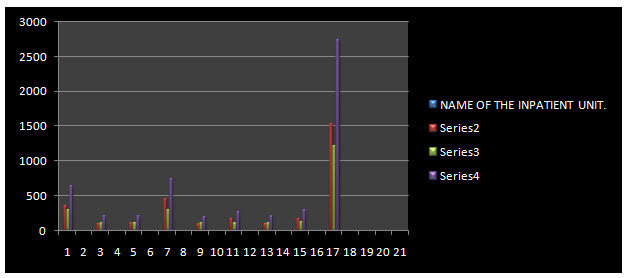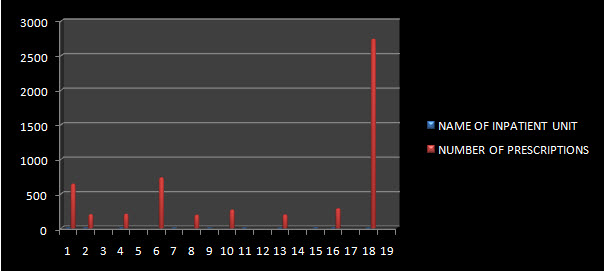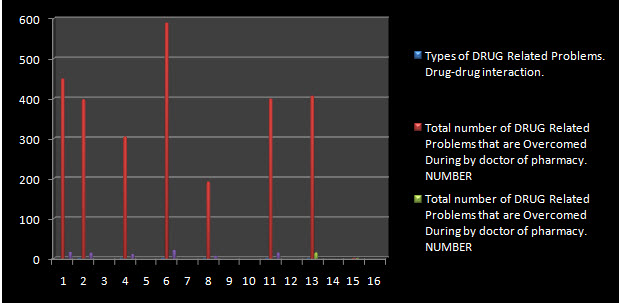{ DOWNLOAD AS PDF }
ABOUT AUHTHORS
M. Manasa Rekha*,
Department of Pharmacy Practice,
Annamacharya college of Pharmacy,
Rajampet, Andhra Pradesh, India.
*manasarekharoyal@gmail.com
ABSTRACT: AIM: The study aims to assess the role of DOCTOR OF PHARMACY in identifying drug related problems in inpatient units in a tertiary care teaching hospital. OBJECTIVES: The main objective of the present study includes identification and reporting of drug related problems like Drug-drug interaction, Adverse drug reactions, Drug use without indication, Therapeutic duplication, Allergy/intolerance/poisoning, Improper drug, dose, route, regimen, Awareness/adherence problems.
[adsense:336x280:8701650588]
Reference Id: PHARMATUTOR-ART-2543
|
PharmaTutor (Print-ISSN: 2394 - 6679; e-ISSN: 2347 - 7881) Volume 5, Issue 12 Received On: 04/08/2017; Accepted On: 08/08/2017; Published On: 01/12/2017 How to cite this article: Rekha MM;A study on role of Doctor of Pharmacy in identifying and reporting of drug related problems and its comorbidities in inpatient units of a teritary care teaching hospital; PharmaTutor; 2017; 5(12);68-73 |
INTRODUCTION: Drug Related Problems are problems that araise due to drug during medication therapy like Drug-drug interaction, Adverse drug reactions, Drug use without indication, Therapeutic duplication, Allergy/intolerance/poisoning, Improper drug, dose, route, regimen, Awareness/adherence problems. Doctor Of Pharmacy is the branch of pharmacy in which pharmacists provide patient care that optimizes the use of medication and promotes health, wellness, and disease prevention. They are Clinical pharmacists who cares for patients in all health care settings but the clinical pharmacy movement initially began inside hospitals and clinics. Clinical pharmacists often work in collaboration with physicians, nurse practitioners and other healthcare professionals.
METHODOLOGY:
AIM:
The study aims to assess the role of DOCTOR OF PHARMACY in identifying drug related problems in inpatient units in a tertiary care teaching hospital.
OBJECTIVES:
The main objective of the present study includes identification and reporting of drug related problems like
1. Drug-drug interaction.
2. Adverse drug reactions.
3. Drug use without indication.
4. Therapeutic duplication.
5. Allergy/intolerance/poisoning.
6. Improper drug, dose, route, regimen.
7. Awareness/adherence problems.
METHODOLOGY:
Study Design: It is a observational and interventional study.
Study Period: The Present study was conducted for a period of 24 months from july 2015 to july2017.
Study site : The Present study was conducted in GENERAL MEDICINE, PEDIATRICS, , OPHTHALMIC, SURGERY, ORTHOPEDICS, ENT, ART, STD Departments at Rajiv Gandhi Institute of Medical Sciences ( RIMS), Kadapa.
Sample size: The Patients admitted in hospital with multiple diseases with poly pharmacy during the study period of 12 months and a total of 2742 prescriptions were collected for this study.
Source of Data: All the patients satisfying the inclusion criteria were selected from GENERAL MEDICINE, PEDIATRICS, OPHTHALMIC, SURGERY, ORTHOPEDICS, ENT, ART, STD department in Rajiv Gandhi institute of medical sciences (RIMS) Government Hospital, Kadapa. All the required data was collected from patients through Patient representative interview and case sheets and treatment charts.
Inclusion criteria:
• Prescriptions of Patients with aging above 18 years with multiple diseases with poly pharmacy, in GENERAL MEDICINE, PEDIATRICS, OPHTHALMIC, SURGERY, ORTHOPEDICS, ENT, ART,STD inpatient wards.
• Prescriptions of Patients having previous history of medical, medication problems
• The Patients who are willing to participate in the study.
Exclusion criteria:
• Prescriptions of Patients who are not willing to Participate in the study.
• Prescriptions of Patients below 18 years of age group.
• Prescriptions Other than GENERAL MEDICINE, PEDIATRICS, OPHTHALMIC, SURGERY, ORTHOPEDICS, ENT, ART, STD all the remaining wards are excluded.
RESULTS:
Table1.1DISTRIBUTION OF MALE AND FEMALE PATIENTS IN DIFFERENT WARDS:
|
NAME OF THE INPATIENT UNIT. |
NUMBER OF FEMALE POPULATION |
NUMBER OF MALE POPULATION |
TOTAL |
|
GENERAL MEDICINE
|
354 |
290 |
644 |
|
PAEDIATRICS
|
98 |
104 |
202 |
|
OPHTHALMIC
|
100 |
108 |
208 |
|
SURGERY
|
450 |
286 |
736 |
|
ORTHOPAEDICS
|
90 |
106 |
196 |
|
ENT
|
169 |
100 |
269 |
|
ART
|
97 |
102 |
199 |
|
STD
|
165 |
123 |
288 |
|
TOTAL |
1523 |
1219 |
2742
|
NOW YOU CAN ALSO PUBLISH YOUR ARTICLE ONLINE.
SUBMIT YOUR ARTICLE/PROJECT AT editor-in-chief@pharmatutor.org
Subscribe to Pharmatutor Alerts by Email
FIND OUT MORE ARTICLES AT OUR DATABASE
Fig 1.1 DIGRAMATIC REPRESENTATION OF DISTRIBUTION OF MALE AND FEMALE PATIENTS IN DIFFERENT WARDS:

Fig1.2 DIAGRAMATIC REPRESENTATION OF DISTRIBUTION OF FEMALE PATIENTS IN DIFFERENT WARDS.

Fig1.3 DIAGRAMATIC REPRESENTATION OF DISTRIBUTION OF MALE PATIENTS IN DIFFERENT WARDS.

TABLE 1.2: DISTRIBUTION OF PRESCRIPTIONS WITH MUTILPLE DISEASES AND WITH POLYPHARMACY IN DIFFERENT WARDS:
|
NAME OF INPATIENT UNIT |
NUMBER OF PRESCRIPTIONS |
|
GENERAL MEDICINE |
644 |
|
PAEDIATRICS
|
202 |
|
OPHTHALMIC
|
208 |
|
SURGERY |
736 |
|
ORTHOPAEDICS |
196 |
|
ENT |
269 |
|
ART |
199
|
|
STD |
288
|
|
TOTAL |
2742.
|
Fig1.4: DIAGRAMATIC REPRESENTATION OF DISTRIBUTION OF PRESCRIPTIONS WITH MUTILPLE DISEASES AND WITH POLYPHARMACY IN DIFFERENT WARDS:

Table.1.3 DISTRIBUTION OF DRUG RELATED PROBLEMS THAT ARE OVERCOMED BT DOCTOR OF PHARMACY.
|
Types of DRUG Related Problems. |
Total number of DRUG Related Problems that are Overcomed During by doctor of pharmacy. |
||
|
Drug-drug interaction.
|
NUMBER |
PERCENTAGE |
|
|
450 |
16.41137 |
||
|
Adverse drug reactions.
|
398 |
14.51495 |
|
|
Drug use without indication.
|
305 |
11.12326 |
|
|
Therapeutic duplication.
|
590 |
21.51714 |
|
|
Allery/intolerance/poisoning.
|
192 |
7.002188 |
|
|
Improper drug, dose, route, regimen.
|
400 |
14.58789 |
|
|
Awareness/adherence problems.
|
407 |
14.843180 |
|
|
|
Total=2742 |
Total percentage=100.
|
|
NOW YOU CAN ALSO PUBLISH YOUR ARTICLE ONLINE.
SUBMIT YOUR ARTICLE/PROJECT AT editor-in-chief@pharmatutor.org
Subscribe to Pharmatutor Alerts by Email
FIND OUT MORE ARTICLES AT OUR DATABASE
Fig.1.5 DIAGRAMATIC REPRESENTATION OF DISTRIBUTION OF DRUG RELATED PROBLEMS THAT ARE OVERCOMED BT DOCTOR OF PHARMACY.

RESULTS AND DICUSSION:
In the present study a total of 2742 prescriptions were analyzed for Drug related problems among them1523 prescriptions belongs to female patients and 1219 prescriptions belongs to male patients. After Analysis the following drug related problems were overcome. Drug-drug interaction (450), Adverse drug reactions (398), Drug use without indication (305),Therapeutic duplication (590),Allergy/intolerance/poisoning (192),Improper drug, dose, route, regimen (400) Awareness/adherence problems(407). And a total of 2742 Drug related problems were resolved .Prism Graph Pad software is used for this study and the P-Value Is < 0.001 which concludes the present study is highly significant.
CONCLUSION:
The present study concludes that Doctor Of Pharmacy professionals are those whose main objective is promotion of appropriate medication usage, and they can prevent the drug related problems which are not yet reported in Indian hospitals. In India there is imbalance between physician and patient ratio as per recent surveys for every 1000 patients there is only one physician available due to this there is increased work load on physician due to this the physician cannot look over the complete safe medication therapy management here Doctor Of Pharmacy can serves as bridge between physician and patient in appropriate medication usage, so it is the duty of Indian government to get involve the Doctor Of Pharmacy in the actual patient care in Indian hospitals where they can prove themselves.
REFERENCES:
1. *M. Manasa rekha ,A. Bharath kumar ---a prospective study on implementation of clinical pharmacy services to general medicine department in a teritary care teaching hospital published in journal of pharma research in ISSN: 2319-5622.
2. American College of Clinical Pharmacy. Pharmacotherapy 2008-28 (6), 816–817.
3. American College of Clinical Pharmacy.The Definition of Clinical Pharmacy. Pharmacotherapy 2008; 28(6):816-817.
4. Kucukarslan SN, Peters M, Mlynarek M, Nafziger DA. Dopharmacists’ presences on rounding teams reduce preventable adverse drug events in hospital general medical units.CMAJ 2004 Feb; 170(3):333.
5. Roberts MS , Stokes JA , King MA, Lynne TA, Purdie DM.Outcomes of a randomized controlled trial of a clinical pharmacy intervention in 52 nursing homes. Br J Clin Pharmacol 2001; 51:257-265.
6. Langebrake C, Hilgarth H. Clinical Pharmacist intervention in German University Hospital. Pharm World Sci 2010; 32:194-199.
7. srinivasan r, ramya g. Adverse drug reaction-causality assessment. international journal of research in pharmacy and chemistry.2011,1(3).
8. dr. rajaram, g., dr. sugirda, p. and dr. lenin, r.Pattern of adverse cutaneous drug reactions presenting to general practitioners in a semi urban area.asian journal of science and technology vol. 6, issue 09, pp. 1788-1790, september, 2015.
9. Jean F Kozak and Akber Mithani.Prevalence of Adverse Drug Events in Long Term Care: Variations in Screening Between Nurses and Physician-Pharmacist Reviewers. HSOA Journal of Gerontology & Geriatric Medicine.2015, 1: 007.
10. American College of Clinical Pharmacy Board of Regents on April 8, 2005. 13000 West 87th Street Parkway, Suite100, Lenexa, KS 66215-4530; e-mail: accp@accp.com, or download from http://www.accp.com.
11.. Chacko Jiyo1, Satish D2. Suthar3,etal Drug utilization study of HIV positive patientsregistered with antiretroviral therapy centre of a tertiary care hospital.
12. National AIDS Control Organization, Govt of India,New Delhi. www.nacoonline.org.
13. Jigar D Kapadia1, Chetna K Desai2, A study of utilization pattern, efficacy and safety ofdrugs prescribed for opportunistic infections in HIV infected patients.
14. Ragesh G., Sindhubharathi A, Ushasri M, Srinivasulu A.A Study On Assessment Of Clinical Pharmacy Services To Cardiology Department In Tertiary Care Teaching Hospital.Int J Pharm Pharm Sci, Vol 6, Issue 2, 192-195.2015.
15. Satish Kumar BP, Prasanna Dhalal, Rajesh Venkataraman. Assessment of Clinical Pharmacist Intervention in Tertiary Care Teaching Hospital of southern India, Asian journal of pharmaceutical and clinical research.,6, 2013, 258-261
NOW YOU CAN ALSO PUBLISH YOUR ARTICLE ONLINE.
SUBMIT YOUR ARTICLE/PROJECT AT editor-in-chief@pharmatutor.org
Subscribe to Pharmatutor Alerts by Email
FIND OUT MORE ARTICLES AT OUR DATABASE










